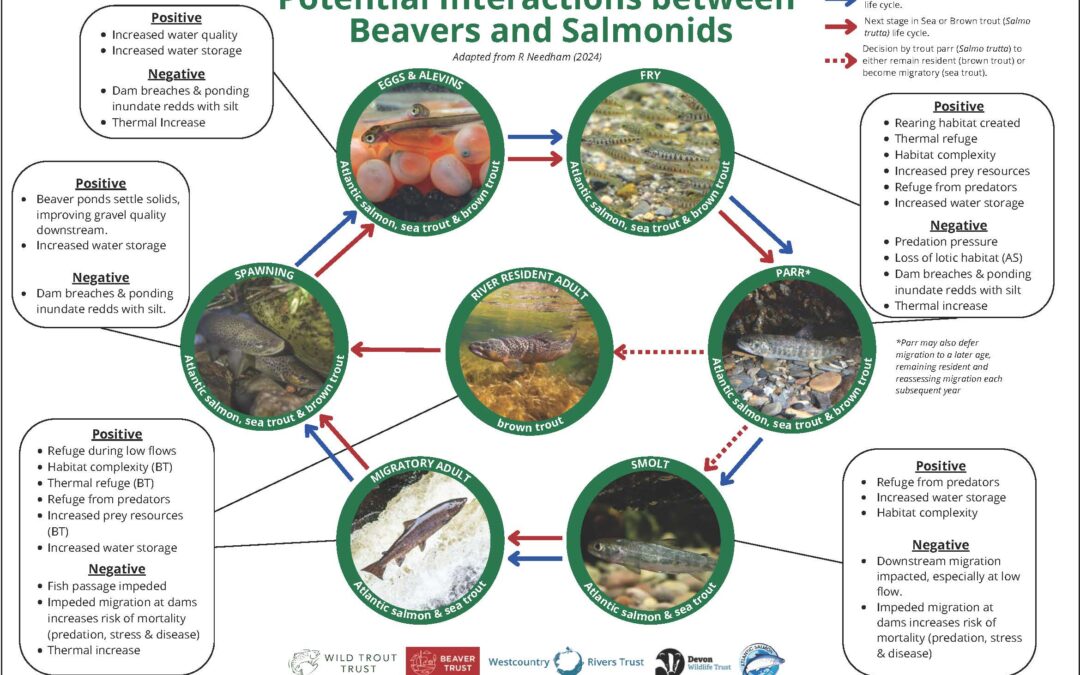 In this blog from our Senior Fisheries Scientist Dr Dan Osmond, he considers the answer to the question, what does the restoration of natural river ecosystems look like?
In this blog from our Senior Fisheries Scientist Dr Dan Osmond, he considers the answer to the question, what does the restoration of natural river ecosystems look like?
“Over millennia of human development and the resulting changes that have occurred to our landscapes, understanding the answer to this question lies beyond the scale of living memory.
“One factor in this dynamic is the native species, the European beaver (Castor fiber). This species has been missing for hundreds of years from the waterways of the UK after being hunted to local extinction.
Reintroduction
“In recent times, the reintroduction of these beavers is creating exciting opportunities for the restoration of natural freshwater habitats.
“Beavers are an ecosystem engineer, not simply improving biodiversity through their interactions but with the creation of unique wetland habitats.
“During the same period of their absence, our rivers have also changed dramatically, with the straightening, canalisation and disconnection of rivers from their increasingly built-upon flood plains.
“How then might beavers interact with this new modified environment – could their introduction offer a solution to the re-naturalisation of river systems, or does the modification of our landscape and loss of space for nature present challenges?
Cited Concerns
“One cited concern within this dynamic is the interaction between the introduction of beavers and migratory fish.
“Atlantic salmon have been listed as endangered by the IUCN in England and Wales, making any potential risk posed by changes to freshwater environments all the more important.
“At the same time, many of the activities that river restoration projects have historically been involved in; input of large woody material, coppicing of bankside vegetation in over shaded reaches and slowing of flows are also performed by this ecosystem engineer, with the additional benefit that beavers don’t charge labour time!
“As a result, Westcountry Rivers Trust has been interested in understanding the potential risks and benefits to our rivers and their migratory fish in relation to the reintroduction of beavers.
“Work led by Dr Robert Needham of the Beaver Trust during his PhD has helped to inform our understanding of the interactions between fish populations and beaver reintroductions, including a paper suggesting higher abundance and size of brown trout within beaver modified environments (Needham et al., 2021 https://doi.org/10.1139/cjfas-2021-0023).
Collaborations
“We have worked collaboratively with the Beaver Trust to adapt some of the findings of this research into more accessible training and information resources to understand the nuances of interactions.
“This takes the conversation forwards from the binary and simplistic arguments of ‘good vs bad’ for fish. It allows us to delve deeper into individual life stages of migratory fishes, the areas of potential risk and benefit to each and thereby allow a more detailed assessment of how these species might interact into the future.
“For example, beaver modified environments offer the potential for more refuge habitat for juvenile fish and increased prey availability to boost growth but may also pose risk in reducing the preferred lotic habitat availability.
“On the contentious factor of potential delays to upstream migration of adult spawning fish and downstream migration of smolts, this collaboration is currently developing a more detailed site-specific assessment tool to enable river managers to quantify these potential risks and assess in which scenarios and locations mitigation might be necessary.
“Cornwall Wildlife Trust (CWT) are currently planning for a licence to release beavers at Helman Tor on the upper Par catchment, with natural dispersal expected into the nearby Fowey catchment.
“We are working with CWT as part of their steering group to assist with designing the planned introductions, to best understand and mitigate any risks to migratory fish populations and to monitor the impact on fish populations.
“As part of this, we have been integrating our electrofishing dataset and regional analysis of this with the Beaver Dam Capacity model produced by the Centre for Resilience in Environment, Water and Waste (CREWW), University of Exeter.
“It has highlighted areas of the catchments of most value to spawning in migratory fish populations and where beaver modification of the environment is most likely to occur.
“This introduction, alongside other introductions of beavers within the Westcountry, allows us to monitor and better understand what influence these beaver-engineered ecosystems might have for our fish populations.
Evidence-led
“Within this, we will continue to make evidence-led assessments for protecting and restoring our wild fish populations through restoration of healthy river ecosystems.”
You can also read our statement in relation to beavers: Beaver Position Statement


Hello,
Thank you for this interesting information. Would it be possible to obtain a copy of this chart, for my personal use only?
Thank you,
Danuta Karpinska